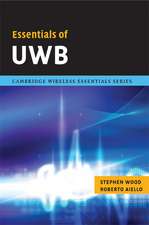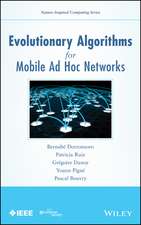Ultra-Low Power Wireless Technologies for Sensor Networks: Integrated Circuits and Systems
Autor Brian Otis, Jan Rabaeyen Limba Engleză Paperback – 8 sep 2011
| Toate formatele și edițiile | Preț | Express |
|---|---|---|
| Paperback (1) | 885.63 lei 43-57 zile | |
| Springer Us – 8 sep 2011 | 885.63 lei 43-57 zile | |
| Hardback (1) | 642.03 lei 43-57 zile | |
| Springer Us – 4 apr 2007 | 642.03 lei 43-57 zile |
Din seria Integrated Circuits and Systems
- 15%
 Preț: 658.22 lei
Preț: 658.22 lei - 18%
 Preț: 1388.68 lei
Preț: 1388.68 lei - 15%
 Preț: 641.71 lei
Preț: 641.71 lei - 18%
 Preț: 1213.46 lei
Preț: 1213.46 lei - 18%
 Preț: 954.45 lei
Preț: 954.45 lei - 15%
 Preț: 650.86 lei
Preț: 650.86 lei - 20%
 Preț: 988.16 lei
Preț: 988.16 lei - 18%
 Preț: 952.09 lei
Preț: 952.09 lei - 18%
 Preț: 950.52 lei
Preț: 950.52 lei - 15%
 Preț: 696.50 lei
Preț: 696.50 lei - 18%
 Preț: 950.21 lei
Preț: 950.21 lei - 18%
 Preț: 953.82 lei
Preț: 953.82 lei - 24%
 Preț: 805.40 lei
Preț: 805.40 lei - 20%
 Preț: 997.38 lei
Preț: 997.38 lei - 15%
 Preț: 634.00 lei
Preț: 634.00 lei - 18%
 Preț: 949.23 lei
Preț: 949.23 lei - 20%
 Preț: 643.63 lei
Preț: 643.63 lei - 18%
 Preț: 1227.36 lei
Preț: 1227.36 lei - 24%
 Preț: 803.82 lei
Preț: 803.82 lei - 15%
 Preț: 649.87 lei
Preț: 649.87 lei - 18%
 Preț: 830.70 lei
Preț: 830.70 lei - 23%
 Preț: 864.82 lei
Preț: 864.82 lei - 15%
 Preț: 635.31 lei
Preț: 635.31 lei - 15%
 Preț: 695.19 lei
Preț: 695.19 lei - 18%
 Preț: 941.05 lei
Preț: 941.05 lei - 15%
 Preț: 641.38 lei
Preț: 641.38 lei - 18%
 Preț: 1001.32 lei
Preț: 1001.32 lei - 18%
 Preț: 946.87 lei
Preț: 946.87 lei - 18%
 Preț: 944.36 lei
Preț: 944.36 lei - 15%
 Preț: 634.18 lei
Preț: 634.18 lei - 18%
 Preț: 956.30 lei
Preț: 956.30 lei - 18%
 Preț: 944.67 lei
Preț: 944.67 lei - 18%
 Preț: 941.05 lei
Preț: 941.05 lei - 18%
 Preț: 953.20 lei
Preț: 953.20 lei - 18%
 Preț: 942.76 lei
Preț: 942.76 lei - 23%
 Preț: 570.64 lei
Preț: 570.64 lei - 18%
 Preț: 952.89 lei
Preț: 952.89 lei
Preț: 885.63 lei
Preț vechi: 1080.04 lei
-18% Nou
Puncte Express: 1328
Preț estimativ în valută:
169.49€ • 176.29$ • 139.92£
169.49€ • 176.29$ • 139.92£
Carte tipărită la comandă
Livrare economică 14-28 aprilie
Preluare comenzi: 021 569.72.76
Specificații
ISBN-13: 9781441940469
ISBN-10: 1441940464
Pagini: 200
Ilustrații: XV, 184 p.
Dimensiuni: 155 x 235 x 11 mm
Greutate: 0.29 kg
Ediția:2007
Editura: Springer Us
Colecția Springer
Seria Integrated Circuits and Systems
Locul publicării:New York, NY, United States
ISBN-10: 1441940464
Pagini: 200
Ilustrații: XV, 184 p.
Dimensiuni: 155 x 235 x 11 mm
Greutate: 0.29 kg
Ediția:2007
Editura: Springer Us
Colecția Springer
Seria Integrated Circuits and Systems
Locul publicării:New York, NY, United States
Public țintă
Professional/practitionerCuprins
Wireless Sensor Networks.- Low Power CMOS Design for Radio Frequencies.- Two Channel Baw-Based Transceiver.- Super-Regenerative Receiver Design.- Fully Integrated Super-Regenerative Transceiver.- Integration Techniques.- Ultra-Low Power Radio in a Package Using Ultra-Wide Band Technology.- Low Energy Wireless Communication.- Conclusions.
Textul de pe ultima copertă
Ultra-Low Power Wireless Technologies for Sensor Networks is written for academic and professional researchers designing communication systems for pervasive and low power applications. The main emphasis of the book is on design techniques for low power, highly integrated transceivers. Instead of presenting a single design perspective, this book presents the design philosophies from three diverse research groups, providing three completely different strategies for achieving similar goals. The following transceiver styles are represented:
Ultra-Low Power Wireless Technologies for Sensor Networks also includes invited chapters: "Ultra-Low Power Radio in a Package Using Ultra-Wideband Technology" by Julien Ryckaert and Steven Sanders from Interuniversity Microelectronics Centre and "Low Energy Wireless Communication" by Ben Cook and Kris Pister from the University of California, Berkeley.
- MEMS-assisted super-regenerative transceiver architecture
- Ultra-wideband transceiver architecture
- Low-IF CMOS transceiver architecture
Ultra-Low Power Wireless Technologies for Sensor Networks also includes invited chapters: "Ultra-Low Power Radio in a Package Using Ultra-Wideband Technology" by Julien Ryckaert and Steven Sanders from Interuniversity Microelectronics Centre and "Low Energy Wireless Communication" by Ben Cook and Kris Pister from the University of California, Berkeley.
Caracteristici
Includes an introduction to wireless sensor networks Problems specific to sensor node communications are described and addressed Design methodologies presented Invited chapters by leading research experts Includes supplementary material: sn.pub/extras










